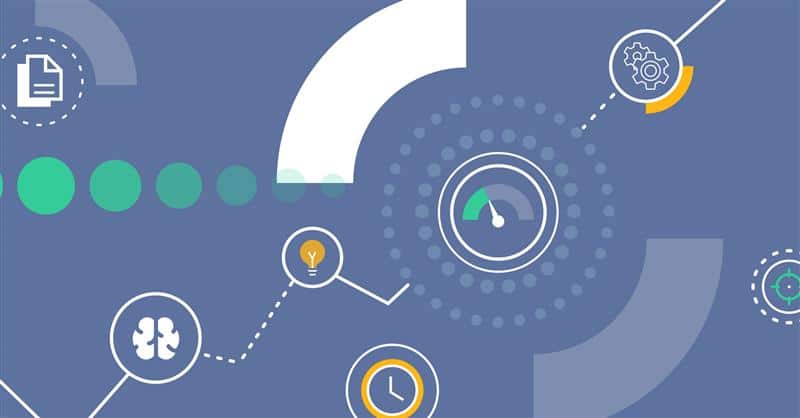-
1.
Low Code/No Code Development Review
- 1.1. What is Low Code?
- 1.2. What is No Code?
- 1.3. Low Code vs No Code: Differences
- 1.4. How do Low Code/No Code Development Technologies Work?
- 1.5. Who Benefits from a Low Code/No Code Platform?
- 1.6. Benefits / Limitations of Low Code/No Code Platforms
- 1.7. FAQs related to Low Code/No Code Development
- 1.8. Conclusion
Low Code/No Code Development Review
Not long ago, businesses had only two ways to develop applications: build them using skilled developers or buy ready-made applications. Fast-forward to today, businesses now have plenty of low code/no code (LCNC) development platforms.
LCNC platforms empower professional developers, “citizens”, and others to develop apps easily without sophisticated coding. Therefore, this guide will uncover all about low code/no code platforms and highlight their working principles, benefits, limitations, differences, and much more.
What is Low Code?
Low code is a process of developing applications using graphical tools and drag-and-drop features that minimize traditional hand-coding. Low code platforms offer drag-and-drop interfaces, pre-constructed components, and templates, which help developers build many application parts visually. However, they still accommodate coding to allow developers to write custom scripts for specific app functionalities.
The main features of low code include:
- Visual modeling
- Drag-and-drop interfaces
- Model-based development
- Pre-built templates
- Hand-coding accessibility
- Scalability
In short, the low code app development method promotes fast development by offering a more accessible user experience. It is ideal for “citizen” developers and even professional developers, as they can leverage the visual integrated development environment (IDE), code templates, and built-in data connectors.
What is No Code?
As the name implies, no code is a process of developing applications without involving any hand-coding. It involves the use of a visual drag-and-drop interface to design the entire app without coding. The no code platforms offer intuitive interfaces, visual workflows, and pre-built components for users to build and deploy applications easily
The main features of no code include:
- Visual, user-friendly interface
- Drag-and-drop functionality
- Pre-build components (buttons, tables, forms, UI elements, etc.)
- Pre-designed templates
In short, no code app development method is best suited for non-technical users or even developers who want to build complete applications from scratch without coding. This makes it the fastest way to develop and deploy applications in minimal time.
Low Code vs No Code: Differences
Both low code and no code development eradicate the need for complete hand-coding from scratch. However, the former offers more customization options than the latter one. Other than that, a few main differences between them are as follows:
1. Target Users
Low code is meant for professional developers to avoid writing basic codes and create room for more complex development for specific app functionalities.
No code is targeted for users with diverse domain knowledge but lacking in the ability of hand-coding.
2. Knowledge
Low code requires basic programming knowledge. Developers should have the knowledge to add custom scripts to develop customized applications.
No code requires no programming knowledge. Any non-technical user can use the no code platform to create the desired application with a simple drag-and-drop interface.
3. Flexibility
Low code offers more flexibility in customizing the app development. It allows adding custom scripts, which means developers can integrate different functionalities in the app.
No code fails to offer that flexibility. Users only get predefined options, which hinders the ability to customize the app functionality.
4. Speed
Although low code offers a visually integrated development environment, it still requires training and onboarding time. Furthermore, app development is faster compared to hand-coding, but it can take time if the specific functionalities of the app require manual coding.
No code development is more like a plug-and-play development methodology. It is easy to get on board and start building apps. It requires significantly less time to develop apps compared to low code. In addition, it lowers the testing and deployment time.
5. Scalability and Cross-platform Compatibility
Low code offers better support for scalability and cross-platform compatibility. It supports adding custom plugins and codes, which increases the possibility of scalability and compatibility across different platforms.
No code scalability and cross-platform compatibility are limited to what the platform offers, reducing the use cases for no code development.
6. Use Cases
Since low code supports developing complex applications, it can offer a wide range of use cases. Its comprehensive component library helps build next-generation applications leveraging AI, ML, etc. Furthermore, it can help develop apps/systems to automate repetitive business processes.
No code use cases are mostly related to front-end apps, such as simple mobile applications, data visualization tools, website development, etc. Simply put, no code platforms are best for creating apps with simple functions and user-friendly interfaces.
How do Low Code/No Code Development Technologies Work?
Traditional app development involves developers writing hundreds of lines of code to create apps/software with desired features. In contrast, a low code/no code platform puts all the coding work behind the scenes, which is termed as “back office” functions.
In LCNC, users get an intuitive interface to pick, drag, and connect components to create the desired workflow. So, the development becomes more like drafting a flowchart.
For example, users developing a mobile app with a low code/no code tool can start by picking pre-built components/templates, such as user interface elements, user authentication, etc. Afterward, they can adjust the components, customize the properties, and complete the application. In the background, the LCNC tool creates the corresponding code. This way, LCNC streamlines the way users develop applications.
The low code/no code platforms also support features like prototyping, testing, and deployment. They may also integrate security features. In short, LNCL transforms traditional hand-coding into modernized, visual-based development.
Who Benefits from a Low Code/No Code Platform?
Low code/no code platforms are for users who either cannot code or don’t have time to code. Although these platforms are built using coding languages like Python, Java, or PHP, the end users get a graphical interface to develop apps.
The common user base of low code platform includes:
- Professional developers – Experienced/professional developers who want to accelerate development.
- Citizen developers – Non-IT employees with little to no coding experience who want to build simple applications.
- Small business owners and entrepreneurs – Business owners or entrepreneurs who want to build apps in minimal time and financial resources.
Similarly, the common user base of no code platform includes:
- Designers – UI/UX or graphic designers who want to prototype a user interface.
- Startups, small business owners, and entrepreneurs – Business owners with no technical expertise but who want to build apps quickly and in a cost-friendly manner.
- Freelancers – Freelancers who want to build the software/app for their client in less time.
- IT/HR/Sales/Marketing department – Different departments of an organization who want to build apps for internal processes.
In short, low code/no code platforms have a wide range of user base, ranging from experts in software development to individuals with zero technical knowledge.
Benefits / Limitations of Low Code/No Code Platforms
According to Gartner, 7% of apps developed by organizations will use low code/no code development technologies by 2025. This is a rapid improvement from 25% in 2020 to almost 70% in 2025. This shows the promising future of low code/no code tools.
So, let’s now look into the key benefits and limitations of low code/no code platforms to understand why/how they are driving the software industry:
Benefits of Low Code/No Code Platforms
- Simplified Development: LCNC platforms simplify how simple to complex apps are developed. Users are able to develop apps with minimal or no coding knowledge at all.
- Faster Development: LCNC platforms accelerate the development process compared to hand-coding. The time to create apps from scratch to final release is reduced significantly.
- Lower Costs: LCNC platforms lower the cost of developing software significantly. Instead of hiring skilled developers to do hand-coding, one or two developers can create the desired software with these platforms.
- Flexibility: LCNC platforms make it easy to upgrade, change, or enhance the design or functionality of the app with the visual interface.
- Room for Innovation: LCNC platforms make developers more productive and save time in repetitive tasks. This then empowers them to think outside the box and come up with innovative ideas.
- Improved Customer Experience: LCNC platforms help create intuitive workflows, friendly interfaces, and quick prototyping, which leads to improved user experience.
- Competitive Edge: LCNC platforms help bring products/services to market faster. Furthermore, the business can adapt products/services quickly to changing requirements.
- Simplified Integrations: LCNC platforms mostly come with pre-built integrations. This simplifies the process of integrating the app with other external services or APIs.
Limitations of Low Code/No Code Platforms
- Limited Customization: LCNC platforms have predefined templates and limited room for customization unless the user is well-trained to add custom scripts.
- Challenging to Build Highly Specialized Apps: LCNC platforms are not handy for developing highly specialized apps with many interlinked complex processes.
- Performance Limitations: LCNC platforms may deal with performance concerns when handling resource-intensive tasks.
- Vendor Lock-in: LCNC platforms can lock the business into proprietary solutions, which then makes it difficult to switch to other platforms.
- Security Concerns: There is always a fear that applications developed with LCNC platforms may be vulnerable to security threats due to lack of technical expertise of users.
- Scaling Complications: LCNC platforms are mostly less friendly to support development by large teams. Furthermore, they may not be capable of handling increased traffic or scaling the app for more complex activities.
Overall, low code/no code development platforms have both benefits and limitations. However, most of the limitations are manageable by using the right LCNC platform and following the right development practices.
FAQs related to Low Code/No Code Development
Q1. What is the difference between low-code and no-code?
Low-code involves visual + hand-coding development approach. Developers can use visual building blocks and add custom scripts for specific functionalities. No-code is entirely visual-based development with no hand-coding involved. It is simply dragging and dropping elements and connecting them to create a full-fledged app.
Q2. When to use low-code?
You can use low-code when prototyping designs, developing web/mobile apps, automating business workflows, building internal apps, etc. In short, almost any software-based development is manageable by low-code platforms.
Q3. What is low code vs zero code examples?
Low code examples can include building web/mobile applications, automating processes, and more. Similarly, zero code examples can include standalone apps, visual dashboards for data representation, content management tools, and more.
Q4. Is low-code really the future?
According to Gartner, low-code application development will lead to 65% of development activities by 2024. So, low-code seems to rule the upcoming development future, as citizen developers will become more active in developing applications with low-code platforms.
Conclusion
Low code/no code development is taking center stage in software development. The market of LCNC platforms is growing rapidly. More businesses/developers are opting for these platforms to expedite development with faster time-to-market and lower costs. However, just like any technology, low code/no code platforms do have limits, but the promising future suggests that they will evolve and tackle those limits over time. To wrap up, there is no denying that low code/no code tools are the future, so businesses should leverage them where possible.






